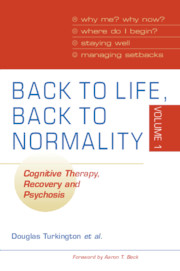Book contents
- Back to Life, Back to Normality
- Back to Life, Back to Normality
- Copyright page
- Contents
- Foreword
- Acknowledgments
- About the authors
- Introduction
- 1 Where do Ibegin? (…or so many problems, so little time!)
- 2 What is normal?
- 3 Understandingparanoia and unusual beliefs
- 4 Voices
- 5 Overcomingnegative symptoms
- 6 Tablets and injections
- 7 Why me? Why now? Understandingvulnerability from a cognitive perspective
- 8 Helpingcarers help themselves using a cognitive approach
- 9 Staying well andmanaging setbacks
- Subject Index
6 - Tablets and injections
Published online by Cambridge University Press: 22 September 2009
- Back to Life, Back to Normality
- Back to Life, Back to Normality
- Copyright page
- Contents
- Foreword
- Acknowledgments
- About the authors
- Introduction
- 1 Where do Ibegin? (…or so many problems, so little time!)
- 2 What is normal?
- 3 Understandingparanoia and unusual beliefs
- 4 Voices
- 5 Overcomingnegative symptoms
- 6 Tablets and injections
- 7 Why me? Why now? Understandingvulnerability from a cognitive perspective
- 8 Helpingcarers help themselves using a cognitive approach
- 9 Staying well andmanaging setbacks
- Subject Index
Summary
This chapter aims to offer the reader an understanding of the role of antipsychotic medicines in facilitating recovery and preventing relapse. The importance of clear communication between patient and doctor is stressed in order that compliance might be optimized.
- Type
- Chapter
- Information
- Back to Life, Back to NormalityCognitive Therapy, Recovery and Psychosis, pp. 93 - 126Publisher: Cambridge University PressPrint publication year: 2009

